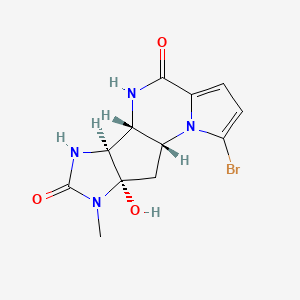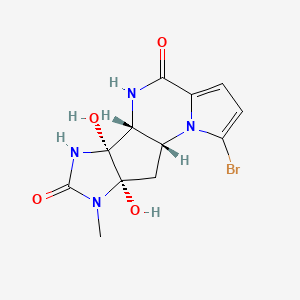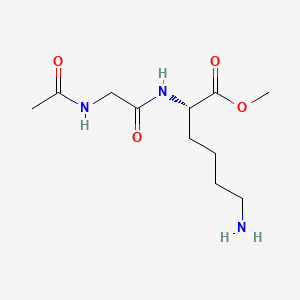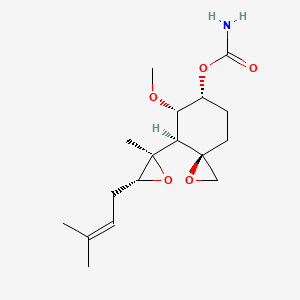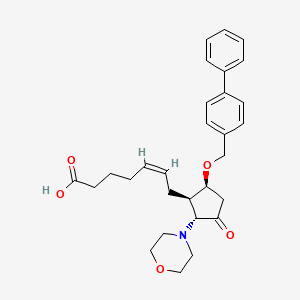
Aplaviroc
Übersicht
Beschreibung
Aplaviroc is a compound that belongs to the class of 2,5-diketopiperazines. It was developed as a CCR5 entry inhibitor for the treatment of HIV infection. The compound was designed to block the entry of the virus into human cells by targeting the CCR5 receptor, which is a critical co-receptor for HIV-1 entry .
Vorbereitungsmethoden
Synthesewege und Reaktionsbedingungen: Die Synthese von Aplaviroc umfasst mehrere Schritte, beginnend mit der Herstellung des Spiro-Diketopiperazin-Kerns. Dieser Kern wird dann mit verschiedenen Substituenten funktionalisiert, um die endgültige Struktur zu erhalten. Die wichtigsten Schritte umfassen:
- Bildung des Diketopiperazinrings.
- Einführung der Butyl- und Cyclohexylgruppen.
- Anlagerung der Phenoxybenzoesäure-Einheit.
Industrielle Produktionsverfahren: Die industrielle Produktion von this compound würde wahrscheinlich eine Optimierung des Synthesewegs beinhalten, um Ausbeute und Reinheit zu maximieren. Dazu gehören die Verwendung hocheffizienter Katalysatoren, kontrollierte Reaktionsbedingungen und Reinigungsverfahren wie Kristallisation und Chromatographie .
Analyse Chemischer Reaktionen
Arten von Reaktionen: Aplaviroc unterliegt verschiedenen Arten von chemischen Reaktionen, darunter:
Oxidation: Die Hydroxylgruppe am Cyclohexylring kann zu einem Keton oxidiert werden.
Reduktion: Der Diketopiperazinring kann unter bestimmten Bedingungen reduziert werden.
Substitution: Die Phenoxygruppe kann durch andere funktionelle Gruppen substituiert werden.
Häufige Reagenzien und Bedingungen:
Oxidation: Reagenzien wie Kaliumpermanganat oder Chromtrioxid.
Reduktion: Reagenzien wie Natriumborhydrid oder Lithiumaluminiumhydrid.
Substitution: Verschiedene Nucleophile unter basischen oder sauren Bedingungen.
Hauptprodukte: Die Hauptprodukte, die aus diesen Reaktionen entstehen, hängen von den spezifischen Bedingungen und verwendeten Reagenzien ab. Beispielsweise würde die Oxidation der Hydroxylgruppe ein Keton ergeben, während Substitutionsreaktionen eine Vielzahl von funktionellen Gruppen einführen könnten .
Wissenschaftliche Forschungsanwendungen
Aplaviroc wurde ausgiebig auf sein Potenzial zur Behandlung von HIV-Infektionen untersucht. Seine primäre Anwendung liegt in der Hemmung des Eintritts des Virus in menschliche Zellen durch Blockierung des CCR5-Rezeptors. Dies macht es zu einem wertvollen Instrument sowohl in klinischen als auch in Forschungsumgebungen, um die HIV-Eintrittsmechanismen zu untersuchen und neue therapeutische Strategien zu entwickeln .
Zusätzlich hat this compound in anderen Bereichen der Forschung Potenzial gezeigt, wie zum Beispiel:
Chemie: Als Modellverbindung zur Untersuchung der Spiro-Diketopiperazin-Chemie.
Biologie: Zur Untersuchung der CCR5-Rezeptorbiologie und seiner Rolle bei verschiedenen Krankheiten.
5. Wirkmechanismus
This compound übt seine Wirkung aus, indem es an den CCR5-Rezeptor auf der Oberfläche menschlicher Zellen bindet. Diese Bindung verhindert, dass sich das HIV-1-Virus an den Rezeptor anlagert und somit seinen Eintritt in die Zelle blockiert. Die Verbindung wirkt als nicht-kompetitiver allosterischer Antagonist, d. h. sie bindet an eine andere Stelle am Rezeptor als der natürliche Ligand und verursacht eine Konformationsänderung, die die Funktion des Rezeptors hemmt .
Ähnliche Verbindungen:
Maraviroc: Ein weiterer CCR5-Antagonist, der in der HIV-Behandlung eingesetzt wird.
Vicriviroc: Ein CCR5-Antagonist in späten klinischen Studien.
PRO140: Ein monoklonaler Antikörper gegen CCR5.
Vergleich: this compound ist in seiner chemischen Struktur einzigartig, insbesondere im Spiro-Diketopiperazin-Kern, der es von anderen CCR5-Antagonisten wie Maraviroc und Vicriviroc unterscheidet. Obwohl alle diese Verbindungen den gleichen Rezeptor angreifen, bietet das spezifische Bindungsprofil und der allosterische Hemmmechanismus von this compound einzigartige Vorteile und Herausforderungen, wie z. B. seine potente antivirale Aktivität und Probleme mit Hepatotoxizität .
Wirkmechanismus
Aplaviroc exerts its effects by binding to the CCR5 receptor on the surface of human cells. This binding prevents the HIV-1 virus from attaching to the receptor, thereby blocking its entry into the cell. The compound acts as a noncompetitive allosteric antagonist, meaning it binds to a different site on the receptor than the natural ligand, causing a conformational change that inhibits the receptor’s function .
Vergleich Mit ähnlichen Verbindungen
Maraviroc: Another CCR5 antagonist used in HIV treatment.
Vicriviroc: A CCR5 antagonist in late clinical trials.
PRO140: A monoclonal antibody against CCR5.
Comparison: Aplaviroc is unique in its chemical structure, particularly the spiro-diketopiperazine core, which distinguishes it from other CCR5 antagonists like maraviroc and vicriviroc. While all these compounds target the same receptor, this compound’s specific binding profile and allosteric inhibition mechanism provide distinct advantages and challenges, such as its potent antiviral activity and issues with hepatotoxicity .
Eigenschaften
IUPAC Name |
4-[4-[[(3R)-1-butyl-3-[(R)-cyclohexyl(hydroxy)methyl]-2,5-dioxo-1,4,9-triazaspiro[5.5]undecan-9-yl]methyl]phenoxy]benzoic acid | |
|---|---|---|
| Source | PubChem | |
| URL | https://pubchem.ncbi.nlm.nih.gov | |
| Description | Data deposited in or computed by PubChem | |
InChI |
InChI=1S/C33H43N3O6/c1-2-3-19-36-30(38)28(29(37)24-7-5-4-6-8-24)34-32(41)33(36)17-20-35(21-18-33)22-23-9-13-26(14-10-23)42-27-15-11-25(12-16-27)31(39)40/h9-16,24,28-29,37H,2-8,17-22H2,1H3,(H,34,41)(H,39,40)/t28-,29-/m1/s1 | |
| Source | PubChem | |
| URL | https://pubchem.ncbi.nlm.nih.gov | |
| Description | Data deposited in or computed by PubChem | |
InChI Key |
GWNOTCOIYUNTQP-FQLXRVMXSA-N | |
| Source | PubChem | |
| URL | https://pubchem.ncbi.nlm.nih.gov | |
| Description | Data deposited in or computed by PubChem | |
Canonical SMILES |
CCCCN1C(=O)C(NC(=O)C12CCN(CC2)CC3=CC=C(C=C3)OC4=CC=C(C=C4)C(=O)O)C(C5CCCCC5)O | |
| Source | PubChem | |
| URL | https://pubchem.ncbi.nlm.nih.gov | |
| Description | Data deposited in or computed by PubChem | |
Isomeric SMILES |
CCCCN1C(=O)[C@H](NC(=O)C12CCN(CC2)CC3=CC=C(C=C3)OC4=CC=C(C=C4)C(=O)O)[C@@H](C5CCCCC5)O | |
| Source | PubChem | |
| URL | https://pubchem.ncbi.nlm.nih.gov | |
| Description | Data deposited in or computed by PubChem | |
Molecular Formula |
C33H43N3O6 | |
| Source | PubChem | |
| URL | https://pubchem.ncbi.nlm.nih.gov | |
| Description | Data deposited in or computed by PubChem | |
DSSTOX Substance ID |
DTXSID6047317 | |
| Record name | Aplaviroc | |
| Source | EPA DSSTox | |
| URL | https://comptox.epa.gov/dashboard/DTXSID6047317 | |
| Description | DSSTox provides a high quality public chemistry resource for supporting improved predictive toxicology. | |
Molecular Weight |
577.7 g/mol | |
| Source | PubChem | |
| URL | https://pubchem.ncbi.nlm.nih.gov | |
| Description | Data deposited in or computed by PubChem | |
Mechanism of Action |
GW873140 is a novel CCR5 receptor antagonist that binds specifically to human CCR5. It binds to human CCR5 with a unique profile as evidenced by the selective inhibition of monoclonal antibody binding. One of the many ways in which CCR5 inhibitors differ from the currently available classes of HIV drugs is that they bind to the host (CCR5 receptor), the cell, target rather than to the viral enzymes in cells like the CD4 cell. | |
| Record name | Aplaviroc | |
| Source | DrugBank | |
| URL | https://www.drugbank.ca/drugs/DB06497 | |
| Description | The DrugBank database is a unique bioinformatics and cheminformatics resource that combines detailed drug (i.e. chemical, pharmacological and pharmaceutical) data with comprehensive drug target (i.e. sequence, structure, and pathway) information. | |
| Explanation | Creative Common's Attribution-NonCommercial 4.0 International License (http://creativecommons.org/licenses/by-nc/4.0/legalcode) | |
CAS No. |
461443-59-4 | |
| Record name | Aplaviroc | |
| Source | CAS Common Chemistry | |
| URL | https://commonchemistry.cas.org/detail?cas_rn=461443-59-4 | |
| Description | CAS Common Chemistry is an open community resource for accessing chemical information. Nearly 500,000 chemical substances from CAS REGISTRY cover areas of community interest, including common and frequently regulated chemicals, and those relevant to high school and undergraduate chemistry classes. This chemical information, curated by our expert scientists, is provided in alignment with our mission as a division of the American Chemical Society. | |
| Explanation | The data from CAS Common Chemistry is provided under a CC-BY-NC 4.0 license, unless otherwise stated. | |
| Record name | Aplaviroc [INN] | |
| Source | ChemIDplus | |
| URL | https://pubchem.ncbi.nlm.nih.gov/substance/?source=chemidplus&sourceid=0461443594 | |
| Description | ChemIDplus is a free, web search system that provides access to the structure and nomenclature authority files used for the identification of chemical substances cited in National Library of Medicine (NLM) databases, including the TOXNET system. | |
| Record name | Aplaviroc | |
| Source | DrugBank | |
| URL | https://www.drugbank.ca/drugs/DB06497 | |
| Description | The DrugBank database is a unique bioinformatics and cheminformatics resource that combines detailed drug (i.e. chemical, pharmacological and pharmaceutical) data with comprehensive drug target (i.e. sequence, structure, and pathway) information. | |
| Explanation | Creative Common's Attribution-NonCommercial 4.0 International License (http://creativecommons.org/licenses/by-nc/4.0/legalcode) | |
| Record name | Aplaviroc | |
| Source | EPA DSSTox | |
| URL | https://comptox.epa.gov/dashboard/DTXSID6047317 | |
| Description | DSSTox provides a high quality public chemistry resource for supporting improved predictive toxicology. | |
| Record name | APLAVIROC | |
| Source | FDA Global Substance Registration System (GSRS) | |
| URL | https://gsrs.ncats.nih.gov/ginas/app/beta/substances/98B425P30V | |
| Description | The FDA Global Substance Registration System (GSRS) enables the efficient and accurate exchange of information on what substances are in regulated products. Instead of relying on names, which vary across regulatory domains, countries, and regions, the GSRS knowledge base makes it possible for substances to be defined by standardized, scientific descriptions. | |
| Explanation | Unless otherwise noted, the contents of the FDA website (www.fda.gov), both text and graphics, are not copyrighted. They are in the public domain and may be republished, reprinted and otherwise used freely by anyone without the need to obtain permission from FDA. Credit to the U.S. Food and Drug Administration as the source is appreciated but not required. | |
Retrosynthesis Analysis
AI-Powered Synthesis Planning: Our tool employs the Template_relevance Pistachio, Template_relevance Bkms_metabolic, Template_relevance Pistachio_ringbreaker, Template_relevance Reaxys, Template_relevance Reaxys_biocatalysis model, leveraging a vast database of chemical reactions to predict feasible synthetic routes.
One-Step Synthesis Focus: Specifically designed for one-step synthesis, it provides concise and direct routes for your target compounds, streamlining the synthesis process.
Accurate Predictions: Utilizing the extensive PISTACHIO, BKMS_METABOLIC, PISTACHIO_RINGBREAKER, REAXYS, REAXYS_BIOCATALYSIS database, our tool offers high-accuracy predictions, reflecting the latest in chemical research and data.
Strategy Settings
| Precursor scoring | Relevance Heuristic |
|---|---|
| Min. plausibility | 0.01 |
| Model | Template_relevance |
| Template Set | Pistachio/Bkms_metabolic/Pistachio_ringbreaker/Reaxys/Reaxys_biocatalysis |
| Top-N result to add to graph | 6 |
Feasible Synthetic Routes
Haftungsausschluss und Informationen zu In-Vitro-Forschungsprodukten
Bitte beachten Sie, dass alle Artikel und Produktinformationen, die auf BenchChem präsentiert werden, ausschließlich zu Informationszwecken bestimmt sind. Die auf BenchChem zum Kauf angebotenen Produkte sind speziell für In-vitro-Studien konzipiert, die außerhalb lebender Organismen durchgeführt werden. In-vitro-Studien, abgeleitet von dem lateinischen Begriff "in Glas", beinhalten Experimente, die in kontrollierten Laborumgebungen unter Verwendung von Zellen oder Geweben durchgeführt werden. Es ist wichtig zu beachten, dass diese Produkte nicht als Arzneimittel oder Medikamente eingestuft sind und keine Zulassung der FDA für die Vorbeugung, Behandlung oder Heilung von medizinischen Zuständen, Beschwerden oder Krankheiten erhalten haben. Wir müssen betonen, dass jede Form der körperlichen Einführung dieser Produkte in Menschen oder Tiere gesetzlich strikt untersagt ist. Es ist unerlässlich, sich an diese Richtlinien zu halten, um die Einhaltung rechtlicher und ethischer Standards in Forschung und Experiment zu gewährleisten.


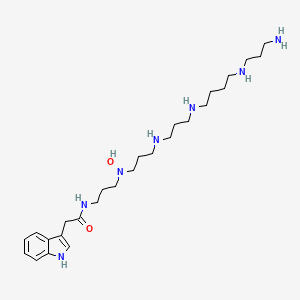
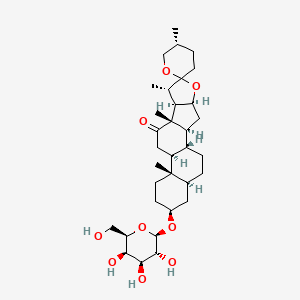
![16-[5-[5-[4,5-Dihydroxy-6-(hydroxymethyl)-3-(3,4,5-trihydroxyoxan-2-yl)oxyoxan-2-yl]oxy-3,4-dihydroxy-6-(hydroxymethyl)oxan-2-yl]oxy-3,4-dihydroxy-6-(hydroxymethyl)oxan-2-yl]oxy-5',7,9,13-tetramethylspiro[5-oxapentacyclo[10.8.0.02,9.04,8.013,18]icosane-6,2'-oxane]-10-one](/img/structure/B1665062.png)
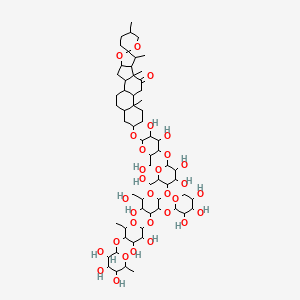
![2-Ethoxy-4-[2-[[3-methyl-1-(2-piperidin-1-ylphenyl)butyl]amino]-2-oxoethyl]benzoic acid](/img/structure/B1665065.png)
